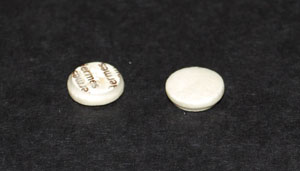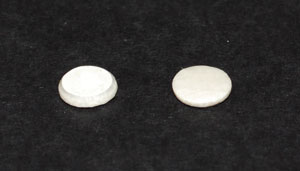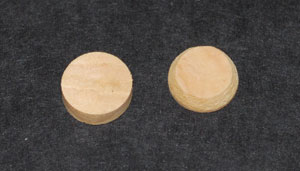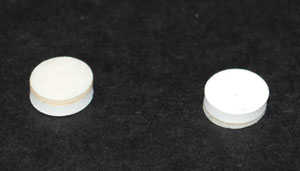Those little white pads underneath each key of a clarinet, flute, or oboe are important components of woodwind instruments. Most students forget about them until one falls out and the instrument is suddenly impossible to play. There are a variety of pads made for upper woodwinds – soft-felt bladder pads, firm-felt bladder pads, cork pads, synthetic pads, and adhesive-backed synthetic pads – and each has certain advantages and disadvantages.

Bladder Pads
Of the many brands and variations of bladder pads, the most common are pads that have bevelled shoulders and those that have angled shoulders, designed with the back part of the pad inside the key cup and the shoulders outside the key cup. Nonbevelled pads are made to be almost entirely recessed within the key cup; they are often used for oboes and piccolos. Larger flute pads have a hole in the center. There are also single- or double-skin pads. (top photo of Bevelled Bladder Pads; bottom photo of Nonbeveled Bladder Pads.)

 Bladder pads are made with three components: a piece of wool felt that conforms to the shape of the tonehole; a cardboard backing that gives strength and durability to the pad; and a piece of sheep’s bladder (sometimes called fish skin) that wraps around the felt and is glued to the cardboard, giving the pad an airtight seal.
Bladder pads are made with three components: a piece of wool felt that conforms to the shape of the tonehole; a cardboard backing that gives strength and durability to the pad; and a piece of sheep’s bladder (sometimes called fish skin) that wraps around the felt and is glued to the cardboard, giving the pad an airtight seal.
Soft-felt bladder pads, which are made with woven felt, are used on many clarinets imported from Asia or are sold as emergency pads, such as the ones found in many band director catalogs. Semi-firm pads are made with woven or pressed felt, and firm-felt bladder pads, which I prefer, are made with pressed felt.
The felt in bladder pads easily conforms to toneholes. Older pads usually have an indentation in the pad, called a seat, showing the outline of the tonehole. Firm-felt pads show little seat and retain their original shape. Consequently, they last longer and feel firmer than the other types of bladder pads.
Installing new pads takes patience and care because the tonehole has to be level and the pad parallel to the tonehole. If it is not parallel, the pad will leak air and cause the instrument to play poorly or not at all. Consequently, pads should be installed only by qualified band instrument repair technicians.
Soft-felt pads show a deep indentation made by the tonehole, making it obvious that they can cover a multitude of sins, such as uneven toneholes and poor installation. The shape of soft-felt pads usually becomes distorted, and larger pads often show a mushrooming quality in the center of the tonehole-seat because of the softness of the felt.
This mushroom can extend into the tonehole when the key is open, causing less air to escape the tonehole and making the note sound stuffy. These pads also have a mushy feel on the open keys, especially when they aren’t installed parallel to the tonehole. If they hit the tonehole in one spot on the pad before another, the first spot will give a little until the lower area hits, producing an insecure feel to the pad and forcing the player to push the key harder to make it seal.
Carpet beetle larvae like the wool felt in bladder pads. When instrument cases are stored for a long period of time, you can sometimes see bites taken out of the bladder pads. This can ruin the seal of the pad. Sometimes the shells of larvae turn up in instrument cases, left from when they matured into adults. When you see these ominous signs of carpet beetle larvae, the clarinet should be repadded and the case replaced to prevent a re-occurrence.
Cork Pads
Cork pads are made from the bark of cork oak trees grown in Portugal. It may seem hard to imagine, but regularly trimming bark from a cork tree contributes to the longevity of the tree, making its life three times longer. Most cork used for woodwind instruments, such as tenon corks, is cross-grain cut, showing the pores. The best cork for cork pads is shive-cut, with the pores running horizontally, eliminating air leakage through the pores.

Cork pads are extremely firm and show little or no seat from the tonehole; because of this firmness players can’t push the key harder to get a poorly fit pad to seal. The toneholes have to be free of chips or distortions that might cause air to leak, and the pads have to be absolutely level to seal the tonehole. To fit a cork pad to the tonehole, the part of the pad that sits inside the key-cup is bevelled, keeping the pad in a position exactly parallel to the tonehole. The bevelling is done by hand sanding the top edge of each pad.
Cork pads cost more than bladder pads because of the time-consuming, skilled hand work necessary to bevel and float each pad correctly. On the positive side, cork pads don’t distort because of their firmness. They are extremely durable, resist wear much better than bladder pads, and can easily last 20 or 30 years. They are impervious to moisture and to the carpet beetle larvae that love to eat the wool felt in bladder pads.
Denatured alcohol or water easily cleans cork pads of cork grease or sticky foods. Although their firmness gives players a secure feel, these pads can make more noise for players when the key is pushed down. The smooth, hard surface of cork pads allows air to escape the tonehole easily, making normally stuffy notes play much more clearly and freely. This is called venting.
Cork pads are traditionally used for the clarinet register key because of this excellent venting characteristic, and because the cork holds up so much longer than bladder pads that touch the metal vent-tube of the register tonehole.
Synthetic Pads
Many types and brands of synthetic pads are made from a variety of materials, especially those used on student clarinets. Most of these pads are nonbevelled and designed to sit inside the pad cup. They are available in white to look like bladder pads or in tan to look like cork pads. The saxophone pads are brown but don’t look at all like leather. I have seen the old red emergency pads on clarinets from band director emergency repair kits that should have been replaced long ago.
One type of pad is made of semi-firm synthetic material and has an adhesive backing. These pads are usually sold to band directors as part of rather expensive repair kits and are helpful as a quick fix when a pad falls out and the student needs the instrument for a rehearsal. The director pulls off a piece of paper to expose the adhesive, then inserts the pad into the pad cup, pressing the back of the key-cup so the pad forms a seat with the tonehole making the clarinet playable. 
The pad material has some give, so the key has somewhat of a mushy feel; if the player pushes the key down firmly, it will seal. These pads actually hamper good technique in the long term because pushing a key harder to get it to seal slows finger movement. This is only an emergency pad, and it should be replaced by a professional repair technician who will be sure a new pad is level with the tonehole.
Professional repair technicians use another type of pad made with the same synthetic material, but it has a paper backing. It has to be slipped into position with some type of glue to make it level with the tonehole. When a pad is level, it hits the tonehole in the back, front, and sides all at the same time; it feels as firm and secure as a good firm bladder pad without any kind of mushy feel.
Heat and Synthetic Pads
A synthetic pad costs about the same as a bladder pad. It takes about the same amount of time and effort to install, so labor costs should be about the same, although many repair technicians charge more because synthetic pads are new. Repair technicians have to be careful of the heat used to slip in and seat the pad because the synthetic material melts at a lower temperature than bladder or cork pads. An overheated synthetic pad causes too deep of a seat, making the pad stick as it rubs the edges of the tonehole; it also distorts the sound coming out of the instrument. Adding even more heat transforms the pad into a melted mess – something to avoid.
Because these pads are made of a synthetic material, they are durable, easy to clean with water or denatured alcohol, and they hold their shape through years of use; they aren’t susceptible to insect damage or humidity change. These pads work well for clarinet register keys and bassoon high notes that normally require cork pads. They don’t feel as firm or vent as well as cork pads, acting more like bladder pads. If a player correctly swabs his clarinet after each use, synthetic pads can last for years, which is also true of bladder pads.
Musicians tend to be conservative people – just try to get a professional clarinetist to try a brand of clarinet other than the one he has played for years. Even though synthetic pads may be superior in many ways, manufacturers and technicians are slow to change to them.
Piccolo and Flute Pads
Although piccolos are manufactured with nonbevelled bladder pads, I prefer synthetic pads for them. These instruments often are used only for marching band in the fall (and occasionally in the spring), then put on the shelf for the rest of the year. Bladder pads on these instruments expand and contract with seasonal humidity changes, making them continuously go out of adjustment. It doesn’t take much change in humidity for piccolo pads to leak. Synthetic pads don’t change significantly with temperature of humidity variations.
Flutes are padded differently than the other woodwinds. They use non-bevelled pads that sit almost entirely within the pad cup, and the pads are secured with screws and washers, not by glue (except for the high C key and two trill keys). The pads are levelled to the toneholes by adding paper shims of various thicknesses.
While flutes come from the factory with bladder pads, I’ve overhauled several flutes and had good success experimenting with synthetic pads. One problem with flute keys is that they are made of soft metal so the key cups easily get bent out of level with the toneholes. I plan to keep traditional bladder pads in stock for play-condition repairs that only require a few replacement pads so they look and sound like the rest of the pads, but I’ll continue to recommend synthetic pads for repadding an entire instrument.
An expensive, high-end variation of the bladder pad can be used on professional flutes; the instrument’s toneholes have to be extremely level for them to work. They use plastic shims instead of paper to eliminate dimensional change in the shims. An overhaul with these pads can cost more than $1,000, and a repair technician has to be trained by the pad maker before he can use them.
Oboe Pads
Most student-model oboes come equipped with bladder pads. Humidity-caused pad leaks, the oboe’s fragility, and the less-than-careful treatment that most school-owned instruments get cause oboes to be sent into the shop a lot.
Better oboes come from the factory with cork pads on all keys except the lower four (low C#, C, B, and B flat), which have bladder pads because cork pads don’t work on the larger keys. Cork-padding helps a lot, but I also like to put synthetic pads on the low four keys because these pads seem to go out of adjustment and leak easily.
Using humidity-stable synthetic pads on these four keys seems to make the low notes play better, longer. They are also a lower-cost alternative to cork pads on the upper keys.
Pads for Clarinets
Most clarinets are still manufactured with bladder pads, except for the register key, whose metal vent tube causes bladder pads to deteriorate. Register key pads are traditionally cork, although many manufacturers now use synthetic pads.
Many clarinetists repad their professional instruments with cork pads, except for the lower four keys: low G#, F#, F, and E, which are generally bladder pads. Cork pads vent much better than bladder pads, thus giving a freer feel to the playing, and they give players a firm, secure feel on notes with open keys. They last many times longer than bladder pads, making it well worth the added expense to cork-pad a good clarinet.
A former Army repair technician at West Point used to repad the band’s plastic clarinets that it used for marching with synthetic pads, making them playable in any type of weather – rain, snow, or sunshine. This might be a good idea for all marching band clarinets. This technician used only cork pads on the band’s professional clarinets because of their firm feel.
Another repair technician in North Carolina specializes in professional clarinets and uses cork pads on most of the keys and synthetic pads on the lowest four keys (G#, F#, F, E) because of the stability of these pads. He says they feel as firm as a firm-felt bladder pad, but once they are set level, they stay that way, regardless of humidity changes.
I repadded my own professional clarinet about 15 years ago, replacing the closed keys (trills A and G#, chromatic B flat/E flat, D flat/A flat, chromatic B/F#) with cork pads and the open keys (ring keys and the lower four keys) with a firm-felt double-skin, bevelled bladder pad. The cork pads allow the closed keys to vent better, getting rid of the stuffy, flat sound. Bladder pads on the open keys are quieter than cork pads when I play those keys, but the firm felt still gives a solid feel to the pad.
To keep the pads of a woodwind in good shape, looking and feeling like they did as a new instrument, I suggest students clean their mouth before they play and carefully swab out the instrument after each use. The pads will continue to look, feel, and play as though they are new.






